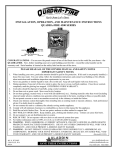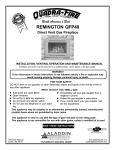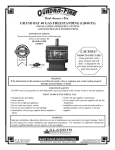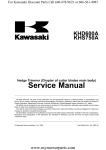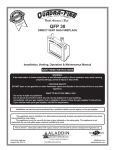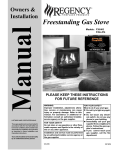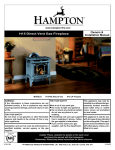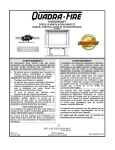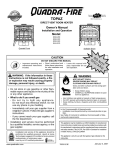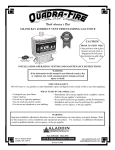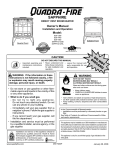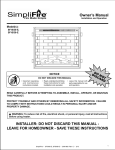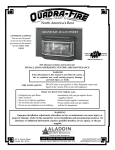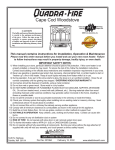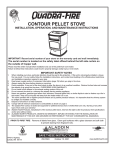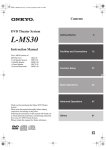Download Quadra-Fire DV-40 User's Manual
Transcript
NorthAmerica’sBest DV-40 STEP TOP DIRECT VENT FREESTANDING GAS STOVE (DV-40 STEP) INSTALLATION, OPERATION, VENTING AND MAINTENANCE INSTRUCTIONS Revised (8/98) CONGRATULATIONS! You are now the proud owner of one of the finest gas stoves on the market - the QUADRA-FIRE. WARNING If the information in this manual is not followed exactly a fire or explosion may result, causing property damage, personal injury or death. FOR YOUR SAFETY DO NOT store or use gasoline or other flammable vapors and liquids in the vicinity of this or any other appliance. WHAT TO DO IF YOU SMELL GAS • • • • • Extinguish any open flame. Open windows. Do not try to light any appliance. Do not touch any electric switch. Do not use any telephone in your building. • • • • Immediately call your gas supplier from a neighbor’s phone. Follow the gas supplier’s instructions. If you cannot reach your gas supplier, call the fire department. Installation and service must be performed by a qualified installer, service agency, or the gas supplier. This appliance may be installed in an aftermarket permanently located, manufactured (mobile) home, where not prohibited by local codes. This appliance is only for use with the type of gas indicated on the rating plate. This appliance is not convertible for use with other gases, unless a certified kit is used. 401 N. Wynne Street Colville, WA 99114 Revised 04/19/1998 Part #250-4320 & #842-3220 SAVE THESEPage INSTRUCTIONS 1 www.aladdinhearth.com [email protected] TABLE OF CONTENTS PAGE Safety Label ............................................................................................................................................. 3 Safety Notices .......................................................................................................................................... 4 Specifications and Listings ....................................................................................................................... 5 Dimensions .............................................................................................................................................. 6 Unpacking the stove ............................................................................................................................... 7 Thermostat installation............................................................................................................................9 Planning your installation ....................................................................................................................... 10 Simpson DuraVent Parts list .................................................................................................................. 12 Clearances to combustibles ................................................................................................................... 14 Hearth requirements .............................................................................................................................. 14 Venting graph ......................................................................................................................................... 15 Venting Instructions ................................................................................................................................ 16 Venting ................................................................................................................................................... 17 Horizontal Installation ....................................................................................................................... 18 Vertical Terminations ........................................................................................................................ 22 Cathedral Ceiling Installation ........................................................................................................ 25 Class A Metal Chimney Installation .............................................................................................. 26 Existing Masonry Chimney Installation ........................................................................................ 27 Gas Line Connection.............................................................................................................................. 30 High Altitude Operation .......................................................................................................................... 31 Gas Conversion Instructions (NG to LP or LP to NG) ............................................................................ 32 Log Installation ....................................................................................................................................... 35 First Fire ................................................................................................................................................. 38 Shutter Adjustment ................................................................................................................................. 38 Lighting Instructions ............................................................................................................................... 39 Pressure Testing .................................................................................................................................... 40 Maintenance ........................................................................................................................................... 41 Vent System ..................................................................................................................................... 41 General Maintenance ....................................................................................................................... 41 Professional Maintenance ................................................................................................................ 41 Cleaning the Burner Tubes .............................................................................................................. 41 Glass cleaning .................................................................................................................................. 41 Blower .............................................................................................................................................. 42 Schematics ............................................................................................................................................. 43 Blower and Snap disc Replacement ...................................................................................................... 44 Accessories/Replacement Parts ............................................................................................................ 45 Pilot Replacement Instructions .............................................................................................................. 46 Flame Troubleshooting .......................................................................................................................... 47 Pilot Troubleshooting ............................................................................................................................. 48 Warranty................................................................................................................................................. 51 Warranty Card ................................................................................................................................... Insert Page 2 DV-40 STEP SAFETY LABEL (FOUND ON PULL-OUT ON BACK OF STOVE) Page 3 SAFETY NOTICES This stove should be installed only by a qualified installer. It is approved for installation in a bedroom. Bedroom installation in Canada requires that stove be hooked to a thermostat. The stove must be electrically grounded in accordance with local codes, or the latest edition of the National Electric Code. If no local codes exist, this stove should be installed following the current codes: CAN/CGA-B149.1............................................................Natural Gas Installation Code CSA-C22.2 No. 3............................................................ Canadian Electrical Code ANSI Z223.1.................................................................... National Fuel Gas Code ANSI NFPA-70..................................................................National Electrical Code Manufactured (mobile) home installation must conform to the manufactured home construction and safety standard (UL307B, Title 24 CFR, Part 3280), or when such a standard is not applicable, the standard for manufactured home installations (ANSI A225.1/NFPA 501A). The control compartment, burner, and circulating air passageways MUST be kept clean and clear to allow for adequate combustion and proper operation. Provide adequate clearances around air openings and adequate accessibility clearance for service and operation. NEVER obstruct the openings of the stove or the vent termination on the exterior of the building. NEVER vent the stove to other rooms or buildings; this stove must be vented ONLY to the outside. During installation, be sure to maintain minimum clearances to combustibles, as shown on page 14. Always contact your local building department or fire department prior to installing this stove. If required, obtain a permit before installing, and have the completed installation inspected. Failure to do this could jeopardize your homeowner’s insurance. The area around the stove MUST be kept free from combustible materials, gasoline and other flammable vapors and liquids. This stove is hot during operation, and should be located out of heavy traffic areas and away from furniture and draperies. Clothing or other flammable material should not be placed on or near the stove. Children and adults should be alerted to the hazards of high surface temperatures and should stay away to avoid burns or clothing ignition. Children should not be left unsupervised in the room when this stove is in operation. Never place anything on or near the heater, the thermostat or remote control can turn the stove on at any time. If any part of this stove has been under water, DO NOT USE it!! Immediately call a qualified service technician to inspect the stove, and to replace any part of the control system or any gas control which has been under water. This stove should NOT be modified under any circumstances. Any parts removed for servicing must be replaced before operating this stove. Installation and repair should only be done by a qualified service technician. The stove and its venting system should be inspected and cleaned annually by a qualified service technician. More frequent cleaning may be necessary due to excess lint and dust from carpeting, bedding material, etc. Be sure to turn off gas valve and pilot before cleaning this stove. Install at least one smoke detector on each floor of your home to ensure your safety. They should be located away from the gas stove and close to the sleeping areas. Follow the smoke detector manufacturer’s placement and installation instructions, and be sure to maintain regularly. Your local fire department may provide assistance in selecting smoke detectors, or contact the Consumer Product See additional Safety Notices on next page. Safety Commission, Washington, D.C. 20207. Page 4 SAFETY NOTICES, CONT. WARNING Do not operate appliance with the glass front removed, cracked or broken. Replacement of the glass should be done by a licensed or qualified service person. WARNING Improper installation, adjustment, alteration, service or maintenance can cause injury or property damage. Refer to this manual for correct installation and operational procedures. For assistance or additional information consult a qualified installer, service agency, or the gas supplier. SPECIFICATIONS Manifold pressure Minimum inlet gas supply pressure Maximum inlet gas supply pressure BTU input rating (high) BTU output rating (high)* BTU input rating (low) BTU output rating (low)* Steady State Efficiency* NATURAL GAS PROPANE 3.5” WC 4.5” WC 7.0” WC 40,000 BTUH 34,000 BTUH 26,000 BTUH 22,100 BTUH 85% 10.0” WC 11 0” WC 14.0” WC 40,000 BTUH 34,000 BTUH 27,000 BTUH 23,000 BTUH 85% *Maximum vent, blower off LISTINGS The Quadra-Fire DV-40 Step is listed to ANSI Z21.88/CSA 2.331998-CAN/CGA 2.17-M91 UL307b by Omni-Test Laboratories, Inc., Beaverton, Oregon. Page 5 DIMENSIONS LEG MODEL 23 3/16" [589m m ] 21 1/2" [546m m ] 24 5/8" [625m m ] 12 9/16" [319m m ] 12 5/16" [313m m ] 6 1/8" [156m m ] 24 7/8" [632m m ] 20 5/8" [524m m ] PEDESTAL MODEL 23 3/16" [589m m ] 21 1/2" [546m m ] 24 5/8" [625m m ] 12 9/16" [319m m ] 12 5/16" [313m m ] 6 1/8" [156m m ] 21" [533m m ] 20 9/16" [522m m ] Page 6 UNPACKING THE STOVE 1. 2. Unbolt pallet using a 7/16” wrench to remove the four bolts from the underside of the pallet. Between the firebox bottom and pallet is an accessories box containing logs, nuggets, touch-up paint, an allen key, and instructions for installation of legs or pedestal. DV-40 STEP LEG ADAPTER ASSEMBLY INSTRUCTIONS 1. 2. 3. 4 5. Remove door from unit and log box located between stove and pallet. Install leg adapter front cover on front of stove as shown (Fig. 1) Remove pallet mounting bolts from underneath pallet and remove stove from pallet. WITH FRONT DOOR REMOVED lay unit down on its front for easy access to bottom. (Fig. 2) Secure leg adapters using 1/4-20 hex head bolts as shown, making sure the bolts are tight. NOTE: The right and left logs are fastened to the stove. Take special care while laying the stove down to not jar and fracture the logs. 6. 7. 8. 9. 10. Secure legs onto the leg adapter pieces using bolts supplied making sure to offset leveling legs as shown. Carefully stand stove up and place in desired location. Use leveling bolts on legs to stabilize and level stove. Check to insure upper baffle and log set are in their proper locations. Replace door on stove. Leg adapter cover Fig. 1 Leg adapters Leveling leg Fig. 2 Page 7 Leveling leg DV40 STEP PEDESTAL INSTALLATION INSTRUCTIONS 1. 2. 3. 4. Remove log box located between stove and pallet Remove door from unit. Remove pallet mounting bolts from underneath pallet and remove stove from pallet WITH FRONT DOOR REMOVED lay unit down on it’s front for easy access to bottom.(Fig. 1) NOTE: The right and left logs are fastened to the stove. Take special care while laying the stove down to not jar and fracture the logs. 5. 6. 7. 8. 9. 10. Slide pedestal assembly on to unit. Line up unit with holes in pedestal adapter and secure with 1/420 bolts supplied. Carefully stand stove up and place in desired location. Tip unit back and slide oak strips onto front of pedestal as shown. (Fig. 2) Repeat step for rear of pedestal. Check to insure upper baffle and log set are in their proper locations. Replace door on stove. Pedestal assembly Pedestal adapter Fig. 1 Fig. 2 Page 8 THERMOSTAT INSTALLATION If desired, a thermostat may be installed to regulate the Quadra-Fire DV-40 Step. It is important to use a thermostat designed for millivolt operation. Do not connect this stove to a thermostat serving any other appliance. Bedroom installation in Canada requires this stove to be hooked to a thermostat. OPTIONAL THERMOSTATS Manual Thermostat Part #812-2880 Anticipator Setting 1.2 Programable Thermostat Part #811-0520 RECOMMENDED MAXIMUM LEAD LENGTH (TWO WIRE) WHEN USING WALL THERMOSTAT/SWITCH Wire Size 16 gauge 18 gauge 20 gauge 22 gauge Maximum Length 65 feet 40 feet 25 feet 18 feet Thermostat Connection Connect the thermostat wires to the outside terminals labled “TH” and “THTP” located on the valve. Turn off the manual switch, located on the control panel. REMOTE CONTROL A remote control or a wall switch may be wired to the thermostat terminals. Contact your Quadra-Fire dealer or service person for details (see page 45 for part number). BLOWER POWER CORD The blower cord is located at the rear of the stove, and needs to be routed to a three-prong outlet with correct polarity. Be sure that the stove is electrically grounded in accordance with local codes, with a current version of CSA C22.2 No. 3 M1988 (in Canada), or in the absence of local codes, with the National Electric Code ANSI/NFPA 70-1987. WARNING Do not cut the grounding terminal off under any circumstances. Do not route the power cord under the body of the stove due to high temperatures. Page 9 PLANNING YOUR INSTALLATION There are four types of direct vent system installations approved for use with the DV40 Step. It is very important to maintain a balance between the combustion air intake and the flue gas exhaust venting system. The types of installation are: Horizontal Termination (Figure 1, Pg. 11) Vertical Termination (Figure 2, Pg. 11) Into a Class A Metal Chimney (Figure 3, Pg. 11)* Into a Masonry Chimney (Figure 4, Pg. 11)* *USA installations only Note: Certain limitations as to vent and vertical termination configuration apply, and must be strictly adhered to. When planning your installation, it will be necessary to select the proper length of vent pipe for your particular requirements. The vent graph on page 15 will show the relationship between vertical and horizontal side wall venting, and will help to determine the various vent lengths permitted. It is also important to note the wall thickness. Select the amount of vertical rise desired for “vertical-to-horizontal” type installations. To determine the length of your pipe required for vertical installations, measure the distance from the application flue outlet to the ceiling, the ceiling thickness, the vertical rise in an attic or second story, and allow for sufficient vent height above the roofline. For two-story applications, fire stops are required at each floor level. If an offset is needed in the attic, additional pipe and elbows will be required. When determining the position of the stove, be sure to adhere to minimum clearance to combustibles to the appliance itself. (See page 14.) When installing this appliance into an existing masonry chimney, it is important to carefully measure the length of flex needed to reach from the appliance outlet to the termination cap. If the flex length is too short, a flex coupler will be needed to attach an additional length of flex liner to make up the difference. If the flex length is too long, the liner could sag below the appliance outlet, which could result in an airflow restriction causing flow reversal or flame lift. Page 10 FOR HORIZONTAL TERMINATIONS USE ONLY DURAVENT PART # 985 OR ALADDIN HEARTH PRODUCTS PART #HHW2 (See * in Figure 1 below). FOR VERTICAL TERMINATIONS USE DURAVENT PART #991. * WALL THIMBLE HORIZONTAL TERMINATION 90 ELBOW VERTICAL TERMINATION Part #991 PART #985 STORM COLLAR OR * PIPE LENGTH FLASHING FIRESTOP HORIZONTAL TERMINATION SUPPORT BOX PART #HHW2 FIG. 2 PIPE LENGTH FIG. 1 APPLIANCE ADAPTER TERMINATION CAP Part # 991 TERMINATION CAP Part # 991 TOP ADAPTER Part # 985K TOP ADAPTER FLASHING EXISTING METAL CHIMNEY SYSTEM 4” FLEX LINER 4” FLEX PIPE RETRO CONNECTOR DIRECT VENT PIPE RETRO CONNECTOR DIRECT VENT PIPE FIG. 3 FIG. 4 (USA installations only) (USA installations only) Page 11 SIMPSON DURA-VENT PARTS LIST Simpson Dura-Vent offers a complete line of component parts for installation in both horizontal and vertical applications. Many items are offered in decorative black, as well as a galvanized finish. The galvanized pipe and fittings are used for concealed locations such as attics, or spaces where corrosion is a factor, such as above the roofline. Decorative brass and chrome trim kits are available for both wall thimbles and ceiling support boxes. Snorkel terminations are available for applications which may require a vertical rise on the building exterior. The following components have been approved for use with the Quadra-Fire DV40 Step. NUMBER 705C 902 902B 903 903B 904 904B 906 906B 907B 908B 909B 911B 940 941 943 943S 945 945B 950 953 963 981 982 983 985 985K 986K 987K 988 990 990B 991 DESCRIPTION Flashing (masonry chimney) 48” Pipe Length 48” Pipe Length, Black 36” Pipe Length 36” Pipe Length, Black 24” Pipe Length 24” Pipe Length, Black 12” Pipe Length 12” Pipe Length, Black 9” Pipe Length, Black 6” Pipe Length, Black Retro Connector 11” - 14 5/8” Pipe, Adjustable, Black Round Support Box/Wall Thimble Cathedral Ceiling Support Box Flashing, 0/12 to 6/12 Roof Pitch Flashing, 7/12 to 12/12 Roof Pitch 45° Elbow 45° Elbow, Black Vinyl Siding Standoff Storm Collar Ceiling Firestop Snorkel Termination (36”) Snorkel Termination (14”) Vertical Termination High Wind Horizontal Termination Cap Top Adapter Top Adapter Top Adapter Wall Strap 90° Elbow 90° Elbow, Black High Wind Vertical Termination Cap The following high wind horizontal termination cap may be obtained from your local dealer: HHW2 Aladdin High Wind Horizontal Termination Cap Page 12 SIMPSON DURA-VENT PARTS LIST (CONT.) BASIC KITS The standard termination kit (Kit 0970A) includes the following: 990B 940 985 1 each 90° Black Elbow 1 each Round Ceiling Support/Wall Thimble 1 each High Wind Horizontal Termination Cap NOTE: The above kit is not a complete termination system. You will need to order the straight pipe lengths needed to complete the installation. The black 45° elbow is not included in this kit. The standard termination kit (Kit 0971HW) includes the following: 990B 940 985 904B 911B 1 each 90° Black Elbow 1 each Round Ceiling Support/Wall Thimble 1 each High Wind Horizontal Termination Cap 1 each 24” Black Pipe 1 each 11” - 14 5/8” Black Adjustable Pipe The vertical termination Kit (Kit 973) includes the following: 943 953 991 1 each Flashing 0/12 - 6/12 1 each Storm Collar 1 each High Wind Vertical Termination Cap NOTE: The support box is not included in this kit. CAUTION: IF DURA-VENT HORIZONTAL OR VERTICAL TERMINATION KITS DO NOT HAVE HIGH WIND TERMINATION CAPS THIS APPLIANCE WILL NOT WORK PROPERLY. Page 13 CLEARANCES TO COMBUSTIBLES Minimum clearances to combustible materials from stove body: A B C D E Left & Right of Stove (One Wall) 9” (225mm) Back wall (to Pipe) 8” (200mm) Top of unit (from Stove Top) 24” (600mm) Corner clearance* 1” (25mm) Alcove (Each Side) 12” (300mm) (Max. Depth) 36” (915mm) * In corner installations one inch is the clearance to combustibles. However, on the valve side of stove, 6 inches may be required to allow safe access to controls. *D B E HEARTH REQUIREMENTS: The floor area beneath the stove must be stable, level and strong enough to support the stove without a tipping hazard. The Leg Model requires a non-combustible hearth pad. The Pedestal Model does not require a non-combustible hearth pad when placed over wood flooring, ceramic tile, brick hearths, or high pressure laminate flooring applied directly over the sub-flooring material. Neither model may be installed over carpet or combustible tile (vinyl tile) without a non-combustible panel extending the full width and depth of the appliance. Page 14 HOW TO USE VENT GRAPH 1. 2. 3. Measure the distance from the top of stove to the center of the 90° elbow. On the graph below, draw a horizontal line from that measurement on the vertical axis across until it intersects with the slanted line. From the point of this intersection, draw a vertical line to the bottom of the graph. The point at which this line meets the bottom line of the graph is the maximum length of the horizontal run. Example 1: If the vertical dimension from the top of the stove to the center of the 90° elbow is 7’ (2.13m), the horizontal run to the outer wall flange must not exceed 9’ 9” (2.97m). Example 2: If the vertical dimension from the top of the stove is 21’ (6.4m), the horizontal run to the outer wall flange must not exceed 7’ 3” (2.21m). Note: The maximum horizontal vent run is 15’ (4.57m) when the vertical vent rise is 10’ (3.05m). The minimum horizontal vent run is 11” (279mm). Minimum wall thickness is 4” (102mm). Maximum wall thickness is 20” (508mm). Page 15 VENTING INSTRUCTIONS PLEASE NOTE: In order to comply with applicable codes and product warranties, only Simpson DuraVent venting components may be used. DO NOT USE FIELD-FABRICATED VENTING COMPONENTS. The Quadra-Fire DV40 Step is approved to be vented either through the side wall or vertically through the roof. You may vent through a Class A or masonry chimney if a Simpson Dura-Vent adapter is used (for USA installations only). Only Simpson Dura-Vent components labeled and listed in this section may be used. IMPORTANT Read all these instructions carefully before starting the installation. Failure to follow instructions may create a fire or other safety hazard, and will void the warranty. Be sure to follow these installation instructions for venting and clearance to combustible requirements, which may vary from one installation to another. Do not extend the venting system in excess of the distance prescribed in these manufacturer’s installation instructions. INSTALLATION PRECAUTIONS The Quadra-Fire DV40 Step is an engineered product that has been designed and tested. The warranty will be voided, and serious fire, health, or other safety hazards may result from any of the following actions: installation of any damaged venting component, unauthorized modification of the venting system, installation of any component part not approved by Aladdin Hearth Products, or installation other than as instructed by these instructions. Consult your local building codes before beginning this installation. Any vertical termination greater than 10’ (ten feet) needs a restrictor strap placed in the top of the 4” (four inch) exhaust outlet of the appliance. Any horizontal termination with greater than 10’ (ten feet) of vertical rise requires this same restrictor strap. (See Pg. 45, Restrictor strap part #842-3330). WARNING: Always maintain the required clearances (air space) to nearby combustibles to avoid creating a fire hazard. Do not fill air space with insulation. Minimum clearance between vent pipes and combustible surfaces is 1” (25mm), except where stated otherwise. Be sure to check the vent termination clearance requirements from decks, windows, soffits, gas regulators, air supply inlets and public walkways, as specified in these installation instructions and local building codes. (Refer to page 18 for horizontal installation instructions.) The gas stove and vent system must be vented directly to the outside of the building, and never be attached to a chimney serving a separate solid fuel or gas-burning appliance. This direct vent gas stove must use its own separate vent system. Common vent systems are prohibited. SAFETY PRECAUTIONS FOR THE INSTALLER Wear gloves and safety glasses for protection when installing this stove. Exercise extreme electrical caution when using ladders or on rooftops. Be aware of electrical wiring locations in walls and ceilings. Page 16 VENTING NOTE: THIS STOVE IS A DIRECT VENT HEATER. ALL COMBUSTION AIR MUST COME DIRECTLY FROM THE OUTSIDE OF THE BUILDING. THE VENT PIPE FOR THIS UNIT CONSISTS OF AN INNER AND AN OUTER PIPE. THE INNER PIPE CARRIES THE STOVE EXHAUST OUT OF THE SYSTEM, AND THE OUTER PIPE BRINGS FRESH COMBUSTION AIR INTO THE STOVE. A B D E F G H I J K L M N Clearance to non-mechanical air supply inlet to building, or the combustion air inlet to any other stove - 12” (305mm) minimum Clearance above paved sidewalk or a paved driveway located on public property - 84” (2.1m) minimum Not to be installed above a meter/regulator assembly within 36” (914mm) horizontally from the centerline of the regulator Clearance to service regulator vent outlet - 72” (1.8m) minimum Clearance above grades, veranda, porch, deck or balcony - 12” (305mm) minimum Clearance to window or door that may be opened - 12” (305mm) minimum on top and sides and 24” below Clearance to permanently closed window - 12” (305mm) recommended to prevent condensation on window Clearance under veranda, porch, deck or balcony - 18” (457mm) minimum if fully open on a minimum two sides beneath the floor Vertical clearance to ventilated soffit located above the terminal within a horizontal distance of 24” (610mm) from the centerline of the terminal - 18” (457mm) minimum Clearance to unventilated soffit - 12” (305mm) minimum Clearance to inside corner - 9” (229mm) minimum Clearance to a mechanical air supply inlet - 72” (1.8m) minimum Clearance to outside corner - 6” (152mm) minimum A vent shall not terminate directly above a sidewalk or paved driveway which is located between two single family dwelling and serves both dwellings (not pictured). A vent shall not terminate within 36" (914mm) of the property line (not pictured). For USA installations follow current National Fuel Gas Code ANSI Z223.1. H Page 17 HORIZONTAL INSTALLATION NOTE: RESTRICTOR STRAP IS REQUIRED IF HORIZONTAL VENTING CONFIGURATION HAS 10’ OR GREATER OF VERTICAL RISE AND NOT MORE THAN ONE 90 DEGREE ELBOW. Step 1. Set the gas stove in its desired location. Check to determine if wall studs or roof rafters are in the way when the venting system is attached. If this is the case, you may want to adjust the location of the stove. Step 2. Simpson Dura-Vent pipe is designed with special twist-lock connections. To connect the venting system to the stove flue outlet, a twist-lock adapter is built into the stove at the factory. Assemble the desired combination of pipe and elbows to the adapter with pipe seams oriented towards the wall or floor, as much out of view as possible. Remember to include wall thickness in minimum clearances when figuring the measurements for your installation needs. Note: Prior to joining pipes apply a high temperature silicone sealant with a rating of 500 degrees Fahrenheit or greater to outside joint of vent pipe. Twist-lock procedure: Four indentations, located on the female ends of pipes and fittings, are designed to slide straight onto the male ends of adjacent pipes and fittings by orienting the four pipe indentations so they match and slide into the four entry slots on the male ends (Figure 5). Push the pipe sections completely together, then twist-lock one section clockwise approximately one-quarter turn, until the two sections are fully locked. The female locking lugs will not be visible from the outside, on the pipe or fittings. They may be located by examining the inside of the female ends. There is a 1/4” rise per foot minimum on horizontal run. NOTE: Horizontal runs of vent must be supported every 3’ (914mm). Wall straps are available for this purpose. (See Parts List, pg. 12) FEMALE LOCKING LUGS FIG. 5 MALE LOCKING LUGS Page 18 HORIZONTAL INSTALLATION (CONT.) Step 3. With the adapter and pipe attached to the stove, slide the stove into its correct location, maintaining minimum clearance to combustibles, and mark the wall for a 10” x 10” (254mm x 254mm) square hole. The center of the square hole should line up with the centerline of the horizontal pipe, as shown in Figure 6. Cut and frame the hole in the exterior wall where the vent will be terminated. If the wall being penetrated is constructed of noncombustible material, i.e. masonry block or concrete, a 7” (178mm) diameter hole is acceptable. NOTE: (1) The horizontal run of vent must be level, or have a ¼” (6mm) rise for every 1’ (305mm) of run towards the termination. Never allow the vent to run downward. This could cause high temperatures and may present the possibility of a fire. (2) The location of the horizontal vent termination on an exterior wall must meet all local and national building codes, and must not be easily blocked or obstructed. (3) For installations requiring a vertical rise on the exterior of the building, 14” (356mm) and 36” (914mm) tall snorkel terminations are available. Follow the same installation procedures as used for standard horizontal terminations. If the snorkel termination must be installed below grade (i.e. basement application), proper drainage must be provided to prevent water from entering the snorkel termination. Do not backfill around snorkel termination. NOTE: With proper vertical rise, refer to Venting Graph on page 15, up to four, 90 degree elbows may be used. Minimum vertical rise in a horizontal venting installation is 2’ (two feet). (See Venting Graph, page 15.) C ENTER O F H O LE CENTER L IN E C E N T E R L IN E Note: USE THE FOLLOWING HORIZONTAL TERMINATION CAPS ONLY! 1) Simpson DuraVentPart #985 OR 2) Aladdin Hearth Products Part #HHW2 FIG. 6 Page 19 HORIZONTAL INSTALLATION (CONT.) Step 4. Position the horizontal vent termination in the center of the 10” (254mm) square hole, and attach to the exterior wall with the four wood screws provided. Before attaching the Vent Termination to the exterior wall, run a bead of non-hardening mastic around its outside edges, so as to make a seal between it and the wall. The arrow on the vent cap should be pointing up. Insure that proper clearances to combustible materials are maintained (Figure 7). NOTE: (1) The four wood screws provided should be replaced with appropriate fasteners to stucco, brick, concrete, or other types of sidings. (2) For buildings with vinyl siding, a vinyl siding standoff (Simpson Dura-Vent part 950), should be installed between the vent cap and the exterior wall (Figure 8). Attach the vinyl siding standoff to the horizontal vent termination. Remove vinyl siding under termination cap. The vinyl siding standoff prevents excessive heat from possibly melting the vinyl siding material. Vent terminal shall not be recessed into a wall or siding. WOOD SCREW FIG. 8 FIG. 7 Part #985 or HHW2 Remove siding from beneath Standoff Page 20 HORIZONTAL INSTALLATION (CONT.) Step 5. Before connecting the horizontal run of vent pipe to the vent termination, slide the black decorative wall thimble cover over the vent pipe. Step 6. Slide the stove and vent assembly towards the wall, carefully inserting the vent pipe into the vent cap assembly. It is important that the vent pipe extend into the vent cap sufficient distance so as to result in a minimum pipe overlap of 1¼” (32mm). Secure the connection between the vent pipe and the vent cap by attaching the two sheet metal strips extending from the vent cap assembly into the outer wall of the vent pipe. Use the two sheet metal screws provided to connect the strips to the pipe section. Bend any remaining portion of the sheet metal strip back towards the vent cap, so it will be concealed by the decorative wall thimble cover (Figure 9). Note: The attachment from the vent pipe to the vent cap must be siliconed. Step 7. Slide the decorative wall thimble up to the wall surface and attach with screws provided. (Figure 10). Apply decorative brass or chrome trim if desired. .der isedder isedd FIG. 9 FIG. 10 Page 21 VERTICAL TERMINATIONS USING GS SERIES PIPE Step 1. Check the installation instructions for required 2 inch clearances (air space) to combustibles when passing through ceilings, walls, roofs, enclosures, attic rafters, or other nearby combustible surfaces. (See page 24, FIG. 16) Do not pack air space with insulation. Check the instructions below for maximum vertical rise of the venting system, and any maximum horizontal offset limitations (Figure 11). All offsets fall within the set parameters of the vent graph located on page 15. NOTE: Maximum vertical rise allowable is 30’ (900 mm) (Figure 12). All vertical installations require the installation of Restrictor strap found in the log box. See Figure A below. FIG. 11 FIG. 12 NOTE: Maximum number of 45 degree elbows permitted for a vertical installation is eight, provided their installation does not decrease maximum vertical rise (as specified by Vent graph, pg. 15). Step 2. Set the gas stove in its desired location. Drop a plumb bob down from the ceiling to the position of the stove flue exit, and mark the location where the vent will penetrate the ceiling. Drill a small hole at this point. Next, drop a plumb bob from the roof to the hole previously drilled in the ceiling, and mark the spot where the vent will penetrate the roof. Determine if ceiling joists, roof rafters, or other framing will obstruct the venting system. You may wish to relocate the stove, or to offset, as shown in Figure 12, to avoid cutting loadbearing members. Step 3. To install the round support box/wall thimble in a flat ceiling, cut a 10” (254mm) square hole in the ceiling, centered on the hole drilled in Step 2. Frame the hole as shown in Figure 13. Placement of Restrictor Strap, Part #842-3330 NOTE: This plate rests on damper shaft. FIG. A FIG. 13 Page 22 VERTICAL TERMINATIONS (CONT.) USING GS SERIES PIPE (CONT.) Step 4. Assemble the desired lengths of GS pipe and elbows necessary to reach from the stove up through the round support box. Insure that all pipe and elbow connections are in their fully twistlocked position. Be sure to seal the outer pipe with appropriate sealant (high temperature silicone). Step 5. Cut a hole in the roof centered on the small drill hole placed in the roof in step 2. The hole should be of sufficient size to meet the minimum requirements for clearance to combustibles, as specified. Continue to assemble lengths of pipe and elbows necessary to reach from the ceiling support box up through the roof line. Galvanized pipe and elbows may be utilized in the attic, as well as above the roofline. The galvanized finish is desirable above the roofline, due to its higher corrosion resistance. NOTE: (1) If an offset is necessary in the attic to avoid obstructions, it is important to support the vent pipe every 3’ (914mm) to avoid excessive stress on the elbows, and possible separation. Wall straps are available for this purpose (Figure 12). (2) Whenever possible, use 45° elbows, instead of 90° elbows. The 45° elbow offers less restriction to the flow of flue gases and intake air. Step 6. Slip the flashing over the pipe section(s) protruding through the roof. Secure the base of the flashing to the roof with roofing nails. Insure the roofing material overlaps the top edge of the flashing as shown in Figure 14. Verify that you have at least the minimum clearance to combustibles at the roofline. (See page 17.) FIG. 14 SHINGLES OVERLAP TOP EDGE OF FLASHING Page 23 VERTICAL TERMINATIONS (CONT.) USING GS SERIES PIPE (CONT.) Step 7. Continue to assemble pipe sections until the height of the vent cap (H) (Figure 15) meets the minimum code requirements described in code requirements as outlined in the current CAN/ CGA-Bl49 Installation Codes (in Canada), the National Fuel Gas Code NFPA 54/ANSI Z223.1 (in USA), or local codes. Note that for steep roof pitches, the vent height must be increased. In high wind conditions, nearby trees adjoining rooflines, steep pitched roofs, and other similar factors can result in poor draft, or down drafting. In these cases increasing the vent height may solve this problem. Step 8. Twist-lock the vent cap and seal. NOTE: (1) For multi-story vertical installations, a ceiling firestop (SDV part #963) is required at the second floor, and any subsequent floors (Figure 16). The opening should be framed to 10” x 10” (254mm x 254mm) inside dimensions, in the same manner as shown in Figure 13. (2) Any occupied areas above the first floor, including closets and storage spaces, which the vertical vent passed through must be enclosed. The enclosure may be framed and sheetrocked with standard construction materials; however, refer to these installation instructions for the minimum allowable clearance between the outside of the vent pipe and the combustible surfaces of the enclosure. Do not fill any of the required air space with insulation. FIG. 15 FIG. 16 Page 24 VERTICAL TERMINATIONS (CONT.) CATHEDRAL CEILING INSTALLATION Step 1. Follow installation Steps 1 and 2 under vertical termination section. Step 2. Using the plumb-bob, mark the centerline of the venting system on the ceiling, and drill a small hole through the ceiling and roof at this point. From the roof, locate the drill hole and mark the outline of the cathedral ceiling support box. Step 3. Remove shingles or other roof covering as necessary to cut the rectangular hole for the support box. Cut the hole 1/8" (3mm) larger than the support box outline. Step 4. Lower the support box through the hole in the roof until the bottom of the box protrudes at least 2” (51mm) below the ceiling (Figure 17). Align the support box both vertically and horizontally with a level. Temporarily tack the support box in place through the inside walls and into the roof sheathing. FIG. 17 Step 5. Using tin snips, cut the support box from the top corners down to the roofline, and fold the resulting flaps over the roof sheathing (Figure 18). Before nailing it to the roof, run a bead of nonhardening mastic around the top edges of the support box to make a seal between it and the roof. Clean out any combustible material from inside the support box. FIG. 18 Step 6. Complete the cathedral ceiling installation by following the same procedures outlines in steps 4 through 8 for vertical terminations. Page 25 VERTICAL TERMINATIONS (CONT.) INSTALLATION INTO A CLASS A METAL CHIMNEY NOTE: Have the existing installation inspected by a qualified chimney sweep or professional installer prior to converting to direct vent. The existing chimney system must be in serviceable condition and functionally sound and clean. Step 1. Remove existing chimney cap. Step 2. Measure the distance from the top of the chimney to the bottom of the ceiling support box, add 3” (76mm) to this measurement, and cut a section of 4” (102mm) flex pipe to that length (the flex should be extended to its nominal length). Step 3. Connect the end of the flex pipe section to the underside of the top adapter (SDV #985K, 986K or 987K), using three sheet metal screws (Figure 19). Step 4. Pass the flex pipe down through the center of the chimney system, and center the top adapter on the top of the chimney pipe. Drill four 1/8” (3.3mm) diameter holes through the top adapter, and into the chimney top. Insure that you are drilling into the metal on the chimney. Twist lock the high wind termination cap (SDV #991) onto the top adapter (Figures 20 and 21). Step 5. Pull the flex pipe down through the ceiling support box, until it protrudes approximately 3” (76mm). Connect the flex pipe to the retro connector (SDV #909B), and attach with sheet metal screws. Step 6. Push the flex pipe back up into the ceiling support box, center the retro connector, and attach it to the support box with sheet metal screws. Step 7. The connection between the appliance and the retro connector may be completed with sections of direct vent pipe. FIG. 19 FIG. 20 FIG. 21 SHEET METAL SCREWS Page 26 VERTICAL TERMINATIONS (CONT.) INSTALLATION INTO AN EXISTING MASONRY CHIMNEY Step 1. Before cutting any holes, assemble the desired sections of direct vent pipe to determine the center of the masonry penetration. Step 2. Once the center point of the penetration has been determined, cut a 6” (152mm) diameter hole in the masonry. If the hole is too large, the retro connector might not mount properly; if the hole is too small, the appliance might starve for intake air. If there is a frame wall in front of the masonry wall, cut and frame a 10” (254mm) square opening in the wall (centered around the 6” [152mm] masonry opening). If there is sheet rock only (no studs) in front of the masonry the 10” (254mm) opening is still needed, but does not need to be framed. This allows the retro connector to mount directly on the masonry and provide the correct clearances to combustibles (see Figure 22). FIG. 22 Step 3. Secure the flashing (SDV #705C) to the top of the masonry chimney using a bead of non-hardening sealant-adhesive. If the flashing is larger than the top of the chimney, cut and fold flashing as needed to fit chimney (Figure 23). Step 4. To determine the length of flex needed, measure from 3” (76mm) above the top of the flashing down to the level of the opening. Add the distance from the center of the chimney out through the wall. Cut a piece of 4” (102mm) flex to this length (extended to its nominal length). Be sure to leave 2”3” (51mm-76mm) of flex above the existing chimney to allow for connection to the termination kit. FIG. 23 Page 27 VERTICAL TERMINATIONS (CONT.) INSTALLATION INTO AN EXISTING MASONRY CHIMNEY (CONT.) Step 5. Connect the flex liner to the top adapter using three sheet metal screws (see Figure 20). Step 6. Feed the flex liner through the flashing into the chimney. Carefully feed the flex liner down the chimney to the bottom and out the opening in the masonry wall, forming an angle to line up the flex liner with the vent opening on the appliance. WARNING: Do not let the flex liner sag below the level at which it will connect to the appliance or connector. This could allow hot gas to become trapped and potentially become a fire hazard. The flex liner path should always be sloped up toward the termination cap. FIG. 24 Step 7. If additional lengths of flex liner are needed to span the chimney height, use a flex coupler to connect the pieces of flex liner together. Connect the flex to the coupler by using four sheet metal screws for each side (Figure 24). TOP ADAPTER Step 8. Secure the top adapter to the flashing. Use three sheet metal screws through the side of the top adapter into the flange on the flashing (Figure 25). Twist lock the high wind termination cap (SDV #991) on to the top adapter. FIG. 25 Page 28 VERTICAL TERMINATIONS (CONT.) INSTALLATION INTO AN EXISTING MASONRY CHIMNEY (CONT.) Step 9. Attach the flex to the retro connector. Use three sheet metal screws to attach the flex liner to the connector (Figure 26). Mount the retro connector to the masonry wall using masonry bolts. Redrill larger holes on connector as needed. Be careful to insure that the connector is centered in the opening and the mounting holes line up with the masonry wall. Step 10. Slide wall thimble cover (SDV #940) over retro connector and secure with masonry bolts (Figure 27). If you have a framed wall in front of the masonry, use wood screws to mount wall thimble cover to framed wall, over retro connector and 10” (254mm) square framed opening (Figure 22). If needed, add a section of direct vent pipe to the retro connector in order to extend through the opening in the wall thimble cover. Step 11. The connection between the appliance and the retro connector may be completed with sections of direct vent pipe. FIG. 26 Step 12. Move the appliance into the desired location. WARNING: IF ANY OTHER APPLIANCES HAVE BEEN PREVIOUSLY ATTACHED TO THIS MASONARY FLUE OR AN OPEN FIREPLACE, ETC., ALL OPENINGS INTO FLUE SHOULD BE SEALED PROPERLY. IT IS VERY IMPORTANT THAT THERE IS ONLY ONE APPLIANCE ON A VENT SYSTEM AND THAT THERE ARE NO AIR LEAKS INTO THE MASONRY CHIMNEY ITSELF OTHER THAN THE VENT APPLIANCE VENTING. FIG. 27 Page 29 GAS LINE CONNECTION Gas line connection can be made near the lower rear of the stove (3/8” gas hookup). You must supply a shutoff valve installed in a visible location within 3’ (914 mm) of the stove. Before hooking up the stove to the gas supply, be sure that the stove you are installing is designed for the type of gas being supplied to it. There is a serial number and listing label on the rear of the stove that will indicate which type of gas it is designed to utilize. There is a 3/8” gas hookup located on the valve. We recommend connecting the stove with an approved flex gas line, as shown below. If flex gas lines are not approved in your area, you can connect a hard pipe to the gas hookup. After running new gas line or if a gas line has been disconnected, purging of the gas line may be necessary. To purge gas line, open the inlet pressure tap and allow gas to flow through while carefully monitoring for the odor of either natural gas or propane. As soon as you smell the gas, discontinue purging the line. Insure that the room has plenty of ventilation and that no sparks or open flames are near the end of the gas line during the purging process. Do not try to ignite the stove until any and all gas accumulation has been cleared from the room. MANIFOLD PRESSURE TAP (Out) INLET PRESSURE TAP (In) CAUTION IN SOME AREAS, GAS LINE PRESSURE MAY BE MORE THAN 1/2 PSIG (14”WC). IF YOU BELIEVE THAT THIS MIGHT BE THE CASE IN YOUR LOCALITY, CONTACT YOUR GAS SUPPLIER OR LOCAL UTILITY COMPANY. LINE PRESSURE GREATER THAN 1/2 PSIG WILL DAMAGE THE STOVE VALVE. YOU MUST INSTALL A REGULATOR UPSTREAM FROM THE STOVE IF LINE PRESSURE IS GREATER THAN 1/2 PSIG. Page 30 HIGH ALTITUDE OPERATION In Canada, this unit is approved from 0 to 4500 feet above sea level. Installation of this stove at altitudes above 4500 feet is subject to field test of the individual installation and approval by the local authority having jurisdiction. In the United States, input ratings of this unit are based on sea level operation, and shall not be changed for operation at elevations up to 2000 feet. For operation at elevations above 2000 feet, this stove shall be reduced at the rate of 4% for each 1000 feet above sea level. Exception: As permitted by the authority having jurisdiction. To adjust stove for operation above 2000 feet the burner orifices may need to be changed. The orifices are located beneath the log set so it is necessary to first remove the logs. To do so please refer to the following detailed instructions to achieve optimum performance of your stove. WARNING ! The following procedure should only be undertaken by a qualified and certified gas appliance installer. CAUTION: DISCONNECT ANY ELECTRICAL CORDS AND TURN OFF GAS SUPPLY TO UNIT BEFORE PROCEEDING. CAUTION: LOGS ARE EXTREMELY FRAGILE 1. Remove the right top log bracket using a Phillips screwdriver (Screws are accessed through rectangular hole in bracket.) See FIG. 4, pg. 37 (Peg in right log bracket.) 2. Remove the right and left side log retaining brackets (one per side). 3. Carefully lift logs vertically off alignment pegs and place in a safe area out of the way of traffic. 4. Use a Phillips screwdriver to remove the top plate of center burner pan located in the middle of the “U” shaped burner. 5. Remove the top plate of left burner pan. 6. The right burner can now be lifted by prying up using a slotted screwdriver to snap burner out of pinch retainer. After burner is lifted, shift to the right to slide off the orifice receiver. 7. The “U” burner is removed using the same technique. Slide the burner out of the shutter ring. You now have access to the orifices. 8. Using a 3/8” socket, remove orifice spuds and replace with correct high altitude orifices: CAUTION: The orifices placement is critical for the correct performance of the appliance. Stock Orifices Front Rear Natural Gas 39 49 Propane 54 56 9. Reinstall burner pans, burners and base logs in reverse order. Page 31 GAS CONVERSION INSTRUCTIONS FOR LP AND NG WARNING ! The installation of this conversion kit must only be undertaken by a qualified and certified gas appliance installer. CAUTION: DISCONNECT ANY ELECTRICAL CORDS AND TURN OFF GAS SUPPLY TO UNIT BEFORE PROCEEDING. Valve Regulator Tower 1. 2. 3. 4. Turn control knob to the OFF position and shut off the gas supply to the valve. Using a Torx T20, or slotted screwdriver, remove the three pressure regulator mounting screws (A), pressure regulator tower (B), and diaphragm (C). (You may wish to retain these items for converting back to original gas if necessary.) Insure that the rubber gasket (D) is properly positioned and install the new HI/LO pressure regulator assembly to the valve using the new screws (E) supplied with the kit. Tighten screws securely. (Reference torque = 25 in/lb) Install the enclosed identification label (F) to the valve body where it can be seen. Page 32 CONVERSION INSTRUCTIONS, (CONT.) Burner Orifice Replacement 5. 6. 7. 8. 9. 10. 11. 12. Remove the right top log bracket using a Phillips screwdriver (Screws are accessed through rectangular hole in bracket.) See Fig. 4, Pg. 37 (Labeled “Peg in right log bracket”) Remove the right and left side log retaining brackets (one per side). (Top of log and firebox side.) Carefully lift logs vertically off alignment pegs and place in a safe area out of the way of traffic. Use a Phillips screwdriver to remove the top plate of the center burner pan located in the middle of the “U” shaped burner. Remove the top plate of left burner pan. The right burner can now be lifted by prying it up using a slotted screwdriver to snap the burner out of pinch retainer. After burner is lifted, shift to the right to slide it off the orifice receiver. The “U” burner is removed using the same technique. Slide the burner out of the shutter ring. You now have access to the orifices. Using a 3/8” socket, remove orifice spuds and replace with the orifices in question. CAUTION: The orifices’ placement is critical for the correct performance of the appliance. Front Rear Natural Gas 39 49 Propane 54 56 NOTE: Logs and burners will be reinstalled following pilot orifice replacement. Page 33 CONVERSION INSTRUCTIONS (CONT.) Pilot Tower Orifice Replacement 13. Loosen (CCW rotation) and remove pilot target hex fitting with a 7/16” end wrench as shown in figure A. FIG. A 14. Remove the currently installed orifice with a pair of needlenose pliers or other means as shown in figure B. FIG. B 15. 16. Install the conversion orifice. Reinstall the pilot target hex fitting and tighten it until the index marks align with each other as shown in figure C. FIG. C 17. 18. 19. 20. 21. Reinstall left burner pan top plate. (Reverse steps 8 & 9) Reinstall center burner pan top plate. Reinstall rear burner by slipping burner end over orifice receiver and snapping into pinch brackets. Reinstall “U” burner by slipping through shutter ring and over orifice receiver and snapping into pinch bracket. Orifice sizes for the pilot are as follows: NG=.026/.023 LP=.026/.016 Log replacement 22. 23. Reinstall in reverse order of steps 5-7. Install nuggets and top logs as instructed on page 35-37 of this manual. Page 34 CONVERSION INSTRUCTIONS, (CONT.) Lighting and pressure testing 24. 25. 26. Apply gas to system and re-light appliance according to lighting instructions. With the main burner “ON”, test the new pressure regulator assembly for leaks using soap bubbles or a gas leak detector. Re-light the main burner in both the HI and LO positions and verify proper burner ignition and operation. INSTALLER NOTICE: These instructions must be left with appliance. LOG INSTALLATION WARNING ! Proper installation of this log set and nuggets are critical to the safety, performance, and aesthetics of this appliance. Follow each step accurately. CAUTION: LOGS ARE EXTREMELY FRAGILE--HANDLE WITH CARE. NOTE: Logs are numbered on the bottom for ease of identification. 1. 2. Remove cardboard box located between firebox and pallet if you have not already done so. Carefully unpack center and top logs and other parts. Loosen door set screw located next to handle in casting using allen key supplied. NOTE: The right and left main logs are shipped inside the firebox of the unit and need to be checked for damage that may have occurred during shipping. 3. 4. 5. 6. Place center log, #23, on positioning pegs in center burner pan with the black char end facing forward. See FIGURE 1 Empty nugget bags on a paper towel or other discardable surface, and place nuggets randomly on top of the “U” burner. Cover entire burner evenly with a single layer of nuggets. See FIGURE 2 Place left top log, #22, on peg of left main log and peg of center log. See FIGURE 3 Place end of right top log, #24, on top of left top log notch, and front of log on the peg of right log bracket. See FIGURE 4 Page 35 LOG INSTALLATION, CONTINUED FIGURE 1 PLACE PEG HOLES IN LOG #23 OVER PEGS IN CENTER BURNER PAN. If damage has occurred to right or left base log, and replacement is necessary, removal is illustrated in conversion instruction steps 5-7. FIGURE 2 DO NOT ALLOW NUGGETS ON BACKSIDE OF THIS PLATE. DO NOT ALLOW LONG LENGTH OF NUGGETS TO BLOCK AIR GAP BETWEEN BURNER PAN AND BURNER. FIGURE 3 LOG #22 PEG HOLES IN LEFT TOP LOG PEG IN CENTER LOG PEG IN LEFT BASE LOG Page 36 LOG INSTALLATION, CONTINUED FIGURE 4 RIGHT TOP LOG #24. PEG HOLE PEG IN RIGHT LOG BRACKET NOTCH FOR RIGHT TOP LOG FINISHED LOG SET CAUTION ! Light appliance with door open to insure there is no hesitation or delay of flame transfer through nugget bed. If ignition is noisy or delayed momentarily, the nuggets in that area may need to be rearranged. Close door and continue with flame adjustment. See “Shutter Adjustment” on following page. Page 37 FIRST FIRE NOTE: Never operate this stove with the door open. Before first firing the stove, read the owner’s manual to familiarize yourself with the stove’s features, controls, and cautions for operation. Remove all labels from glass before operating this stove for the first time. Plug power cord into a properly installed outlet for blower operation. During your first fire in the stove, you may notice an odor and steam coming from the stove. This is normal, it is the high temperature paint finishing the curing process. Open doors and windows in your home or structure for ventilation. 1. Follow the procedure under lighting instructions on page 39 of this manual (also located on the back of the stove). 2. After a flame has been established for 2 minutes, turn off the burner switch located at the top right of appliance. Turn this switch on and off while watching the flame area of stove to verify correct lighting through the nugget bed. If ignition is noisy or is delayed momentarily, the nuggets in that area may need to be rearranged. 3. Allow flame to burn for at least 20 minutes or until orange halo in the flame disapears. It is recommended that the stove be cycled by turning stove on for twenty minutes, and then turned off to cool for five minutes. Then turn the stove back on and burn until the steam and/or odor are no longer present. If odor persists, turn the gas supply to the stove off and call your local dealer or authorized service agent. The blower system has an on/off thermally operated snap disc that will turn the blower on automatically when the proper temperature is reached and turns the blower off when the temperature cools. You may also turn the blower on or off manually and adjust the volume. It will still be necessary for the snap disc to be up to temp. The blower controls are located on a box at the right rear top of stove. SHUTTER ADJUSTMENT 1. 2. 3. 4. 5. Remove left side panel prior to lighting stove. Light stove and let unit burn for approximately 20 minutes to allow logs to cure. While logs are curing you may notice a bright orange flame, this is normal. When this flame turns to yellow or disappears, the shutter adjustment can take place. The shutter is pre-set at the factory so shutter adjustment may not be necessary. If flame height adjustment is required, turn the adjustment screw clockwise to close shutter and obtain a yellow flame. For a blue flame with more glow, turn the adjustment screw counter-clockwise to open the shutter. Wait five minutes to allow for flame to settle. If the flame is not satisfactory, repeat the procedure in step #3. When the desired flame is acquired, replace the side panel. CAUTION: DO NOT CLOSE THE SHUTTER TO THE POINT THAT THE FLAMES ARE TALL AND STRINGY. THIS COULD RESULT IN THE FORMATION OF SOOT BOTH INSIDE THE FIREBOX AND ON THE OUTSIDE OF YOUR HOME. Page 38 LIGHTING INSTRUCTIONS (LOCATED ON PULL-UP AT LEFT REAR OF STOVE) Page 39 PRESSURE TESTING This appliance must be disconnected from the gas supply piping system if any testing is done to the system that exceeds the test pressure of 1/2 PSIG. If the test pressure is less than or equal to 1/2 PSIG, then this appliance must be isolated from the piping system by closing its individual shutoff valve. The gas valve is supplied with pressure test ports for checking input and output pressures. These are located just above the on/off knob and can be found at the rear of the appliance. Pressure can be checked by turning the captured screw counterclockwise two or three turns and then placing the manometer tubing over the test port. The inlet pressure should be checked with the burner lit. BE SURE TO CLOSE CAPTURED SCREWS AFTER TESTING BY TURNING THEM CLOCKWISE. DO NOT OVERTIGHTEN SCREWS. NOTE: to make flame and heat output adjustments, turn the HI-LO knob located on the center of the valve (as seen below). Turn counterclockwise for a higher flame and clockwise for a lower flame. NOTICE: Inlet and Manifold Pressures can only be taken with the burner lit. IN Page 40 IN P U T S ID E T E S T VA LV E (Inlet Pressure) O U T P U T S ID E T E S T VA LV E (Manifold Pressure) OUT MAINTENANCE CLEANING AND INSPECTION OF VENTING SYSTEM At least once yearly, preferably before the heating season, have the insert and venting system cleaned and inspected by a qualified service person. This will insure proper and safe operation throughout the year. CLEANING THE BURNER TUBES 1. 2. 3. 4. 5. 6. 7. 8. PILOT HOOD Turn off pilot light. Loosen set screw in casting by latch and open door. Remove logs and glowing charcoals. (See Burner orifice Replacement, Pg. 33) Vacuum burner compartment, especially around orifice and primary air openings. Relight pilot. Check to insure flames are touching millivolt generator (see diagram at right). Reinstall logs. See page 33, 35-37 for log installation instructions. Close front door and lock it in place with the allen screw. Recheck pilot and main burner to insure they are operating correctly. MILLIVOLT GENERATOR THERMOCOUPLE GLASS CLEANING WARNING: DO NOT CLEAN GLASS WHEN HOT. 1. 2. 3. 4. 5. Turn off pilot. Loosen set screw in casting by latch and open door. Using Kel Kem glass cleaner, spray the glass surface and wipe with soft cloth or clean paper towel until surface is dry. Close door and tighten allen screw to prevent opening of the door while in operation. Relight pilot and check main burner’s operation. NOTE: If you observe a white film on the door glass, use a hard water deposit glass cleaner or contact your dealer. The use of Kel Kem glass cleaner will reduce the mineral deposits. NOTE: Do not use abrasive materials or chemical cleaners. CARE AND CLEANING OF GOLD DOOR TRIM WARNING: You must clean all the fingerprints and oils from the gold surface before firing the appliance for the first time. Use a glass cleaner or vinegar and a towel to remove the oils. If not cleaned properly before lighting your first fire, the oils can cause permanent markings on the gold plating. After the gold plating is cured, the oils will not affect the finish and little maintenance is required, just wipe clean as needed. WARNING: DO NOT USE ABRASIVE CLEANERS ON GLASS OR GOLD SURFACES. Page 41 BLOWER CLEANING AND/OR REPLACEMENT Cleaning is recommended at least once yearly or as needed. 1. Disconnect power and turn off gas supply. 2. Unplug blower at molex connector (see “A” below). 3. Remove two screws on back plate of blower compartment. 4. Slide blower compartment away from stove. 5. Vacuum or brush off dust and lint from fan blades. For Replacement: Follow instructions above for removal of blower. Re-install new blower: 1. Key two fingers on the blower compartment into slots on stove back. 2. Connect the molex connector. (See “A” in figure below) 3. Rotate the compartment up. 4. Insert and tighten the two screws. 5. Reconnect power and turn on gas supply. “A” Close up of molex connection. Note: Take care not to lose the rubber on blower compartment fingers. If rubber is removed vibration can occur during blower operation. Blower compartment fingers. Page 42 SCHEMATICS B Orange=O Black=B White=W Red=R Green=G O Page 43 SNAP DISC REPLACEMENT 1. Disconnect power from unit and turn off gas supply. 2. Remove four screws as shown in figure below and take off rear heatshield. 3. Remove all wires attached to snap disc. 4. Remove set screws holding snap disc in place. 5. Replace in reverse order. REAR HEAT SHIELD SNAP DISC Page 44 ACCESSORIES These may be ordered through your Quadra-Fire dealer. 812-2880 811-0520 844-0100 Thermostat, manual Thermostat, programable Thermostatic Remote Control REPLACEMENT PARTS 842-3200 842-3230 842-3210 842-0380 832-2970 841-0670 842-3270 842-3190 842-0380 842-1100 842-0250 842-2500 842-3290 842-3300 841-0370 842-3220 842-0360 842-2450 842-3420 842-3430 842-3330 842-1660 842-3250 842-1580 842-3280 842-3240 Baffle Black door with gold trim ring Blower assembly, 160 cfm Blower cord, 6 foot Blower snap disc, ceramic, 125 degree DV40 Step Top log set L burner LP conversion kit LP Orifices Front LP Orifices Rear Millivolt generator (thermopile) NG conversion kit NG Orifices Front NG Orifices Rear Nuggets, charred Owner’s Manual Piezo igniter Pilot assembly, NG Pilot Orifice, NG Pilot Orifice, LP Restrictor Strap Rocker switch, high temperature Speed control with knob Thermocouple U burner Wire harness Page 45 PILOT REPLACEMENT INSTRUCTIONS 1) If log set is installed, remove the top logs, center log, ember nuggets and left base log. If log set is not installed remove only left base log. 2) Remove six #8/32 screws that hold the center burner pan in place. Lift burner pan out of firebox and set aside. 3) Remove two #8/32 screws that hold pilot assembly plate to the pilot tower. 4) Disconnect igniter wire from piezo. Using a 5/32” allen wrench, loosen the two back screws on the valve body which hold the valve cover in place. Remove three #8/32 screws at the top of valve cover, set valve cover aside. 5) Disconnect thermopile wires from the TH/TP and TP terminals on the valve body with a standard screwdriver. 6) With a 3/8” wrench, disconnect thermocouple from bottom of valve body. 7) With a 7/16” wrench, remove pilot line from the valve body. 8) For easier access to the pilot assembly remove blower from unit by disconnecting wires, then loosen two mouonting screws with a #2 Phillips screwdriver. Blower will now drop down and slide towards back of the appliance for removal, set blower aside. 9) Straighten pilot supply line tubing and thermocouple wire and push pilot assembly up through firebox bottom. Remove pilot assembly from firebox. 10) Install new pilot assembly (igniter towards the back of appliance) and fasten down with two #8/32 screws. 11) Reassemble appliance in reverse order. (When reconecting pilot supply line to the valve body, do not over-tighten fitting.) NOTE: Pilot supply line is flexible, be sure when routing pilot assembly lines and wires not to interfere with blower placement. Page 46 FLAME TROUBLESHOOTING NOTE: It is important to understand that the flame and glow in this appliance was designed to resemble a matured wood flame. The amount of charcoal nuggets and glowing ember limit the amount of flame height attainable. This appliance will not have the typical tall yellow gas unit flames. (Avg. flame height 35”). This stove will take 20-30 minutes for the flame to establish itself. Caution: This appliance is only approved for the following termination caps: DuraVent part #985, High wind Horizontal, HTI/Aladdin part #HHW2 High wind Horizontal, and DuraVent part #991, High wind vertical. Other caps cannot be substituted. Caution: A restrictor strap (HTI/Aladdin Part #842-3330, included with appliance) is required for vertical installations. Low flame height will result if restrictor strap is not installed for vertical applications. See Figure B on following page. NOTE: This unit was not designed to have flames exiting holes in the right base log. The burner should have a low blue flame with only heat exiting log causing parameter of holes to glow. Low Flames (correct flame height is 3-5”) Twenty to thirty minutes of burning is required for this unit to equalize temperature therefore attaining correct flame height and color. If flame after this time is inadequate: 1. Turn burner shutter clockwise (see illustration in Figure A below), looking periodically for increase in flame height. Do not close shutter to the point that flames become dark yellow with black tips, this will cause a deposit of carbon both in the firebox and possibly on the siding of your home. If no noticeable change occurs to the flame, continue to step 2. Burner shutter adjustment screw. FIG. A Page 47 Flame Troubleshooting, cont. 2. If vertically vented, a restrictor strap is required to reduce the volume of combustion air, which in turn will raise the flame height. Restrictor Strap NOTE: This plate rests on damper shaft. FIG. B 3. If vented vertically with a horizontal run included; determine if the rise to run is close to the venting graft maximum, i.e. you are using the maximum horizontal for the amount of vertical. If the vertical rise is much greater than the horizontal run the restrictor strap may be installed to slow combustion air. If this method is used, light the stove for the first time and watch for flame lift (blue flame 1-30 seconds lifting off burner and hovering in the middle of the firebox.) If this is visible immediately shut the gas valve off and remove the restrictor strap. Flame height can now be further adjusted by using shutter adjustment previously described in step 1. Tall Stringy Flame Single tall flame 1. If there is a single flame that is tall and stringy and the other flames look acceptable, 1-3 nuggets can be placed on top of the flame origin. This will increase glow at this point and cause the flame to turn semitransparent. If nuggets are added to the rear left of the firebox, make sure that the pilot flame is not blocked from lighting the burner. Many tall flames 1. If the appearances of the majority of the flames are tall and stringy, the entire burner needs more primary air. This can be accomplished by turning the shutter adjustment counter-clockwise. See Figure A on previous page. Page 48 PILOT TROUBLESHOOTING A. B. C. Pilot won’t light 1. Make sure valve setting is in the pilot position. 2. Check for spark at igniter. a. If no spark: 1. Check the wiring between the piezo and the igniter. Wire may be looped and be sparking to stove body. If so, move wiring. Check tightness of piezo mounting nut. If this does not remedy the problem you may have a faulty piezo or cracked ceramic on the electrode. 2. Call your Quadra-Fire dealer. b. If there is a spark: 1. Try to light the pilot with a match (use caution when doing this.) First open door and smell for gas, then toss lit match below pilot. Watch for blue flame. The flame should either light or flutter. a. If the flame flutters but does not light the pilot, there is probably air in the line. Hold match or lighter flame to pilot hood, then bleed the line until gas comes through. b. If the match flame does not flutter, make sure the gas is turned on and be sure you are pushing the knob in all the way. If this still doesn’t help, you may be dealing with a bad valve, a blocked pilot orifice, or a kinked pilot line. 3. Call your dealer or authorized service person. Pilot goes out when knob is released 1. Wait five minutes and try again. If the pilot still goes out, try again and hold the knob in longer. 2. If the problem persists, look to see that the pilot flame is contacting thermopile and thermocouple, see picture on following page. If flame is not contacting thermopile and thermocouple, pilot adjustment screw can be turned counter clockwise to increase pilot flame. If flames do not increase, chances are the inlet pressure is low. The inlet pressure cannot be checked accurately unless burner is lit. Turn off gas supply valve and disconnect from appliance. Quickly turn on and listen for ample gas supply. If volume is good, call your dealer or authorized service person. Pilot lights but burner won’t ignite 1. Make sure the knob is turned to the “on” position. 2. Turn the thermostat up. Make sure burner switch is in the OFF position. 3. If there is no thermostat, flip the manual switch on the control panel of the stove. If the burner does not light, short out the thermostat screws on the face of valve marked TH and TPTH. If the burner lights, you may have a problem in the wiring of the stove, and it should be checked. 4. Check the thermostat and thermopile connections at the valve, and tighten or reconnect if needed. Check thermopile connections for grounding. Check that thermopile lead nut is snug. (Do not over tighten.) 5. If the burner still will not ignite, you may have a bad valve; call your dealer or authorized service person. Check the pilot and burner flames periodically. When properly adjusted, the pilot flame should look like the illustration on the following page. Call your dealer or authorized service person to have the pilot properly adjusted. Page 49 FLAMES Thermopile Pilot Hood (Millivolt Generator) Thermocouple PILOT ASSEMBLY SHOWING FLAME PROPERLY ADJUSTED. Page 50 NorthAmerica’sBest GAS STOVE LIMITED LIFETIME WARRANTY Aladdin Hearth Products, warrants this gas heating appliance to the original purchaser for the lifetime of the appliance, to be free from defects in material and workmanship. This warranty gives you specific legal rights; you may have other rights which may vary from state to state. This limited Lifetime Warranty covers items such as but not limited to combustion chambers, burners, gas logs, and gold plating. All parts to be replaced must be returned to an authorized Aladdin Hearth Products dealer at purchaser’s expense for inspection and approval by Aladdin Hearth Products prior to repair or replacement. No repair or replacement costs will be honored without approval of Aladdin Hearth Products. This new Quadra-Fire product must be installed by a competent, authorized service contractor. It must be installed and operated at all times in accordance with the Installation, Operation and Maintenance Instructions furnished with this product, as well as any applicable local and national codes. Any alteration, willful abuse, accident, or misuse of the product shall void this warranty. Any installation, construction, transportation, or other related costs or expenses arising from defective part(s), repair, replacement, etc., will not be covered by this warranty, nor will Aladdin Hearth Products assume responsibility for them. Further, Aladdin Hearth Products will not be responsible for any incidental, indirect, or consequential damages, except as provided by law. All electrical components such as but not limited to blowers, wiring, thermodisc switches and gas valves are covered by Aladdin’s one year warranty program. Aladdin Hearth Products will not be responsible for any alteration to the unit which causes sooting that results in damage to the interior of the building in which this appliance is installed. This warranty is void if the stove has been operated in atmospheres contaminated by chlorine, fluorine, or other damaging chemicals, or the stove is subjected to prolonged periods of dampness or condensation. This limited Lifetime Warranty does not extend to or include paint or ceramic insulating materials. It does not cover installation or operational related problems such as overfiring, or negative air pressures caused by mechanical systems such as furnaces, fans, clothes dryers, etc. This limited Lifetime Warranty does not apply to hearth components or other accessories used in conjunction with the installation of this product not manufactured by Aladdin Hearth Products. This limited Lifetime Warranty is effective on all gas stoves sold after September 1, 1996, and supersedes any and all warranties currently in existence. IMPORTANT This warranty is not valid unless the warranty registration card has been properly completed in full and returned within 10 days from the date of purchase to Aladdin Hearth Products, 401 North Wynne Street, Colville, WA 991142153. Proof of purchase is required to secure warranty. FOR YOUR RECORDS Date of Purchase ______________________________ Model # _____________________________________ Authorized Dealer ______________________________ Serial # ______________________________________ Copyright Aladdin Hearth Products, September 1997 (842-3220)



















































